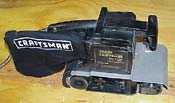 |
Click image to enlarge |
Belt Sander - Craftsman
1 -HP, 4X21-inch belt
Text & Photos by Tom Hintz
When I need to remove a large amount of material, I reach for this tool. Even with belts in the 120-grit range, this sander makes short work of eliminating those frustrating ridges, high spots and other imperfections that stand between all woodworkers and a glass-smooth finish. Need to round a corner on a thick piece of wood? Not a problem. Bring out the big belt sander.
I have used this sander often over the years and have had no problems with it at all. Even the belt tracking adjustment requires little attention after being set for the current belt.
The biggest problem I have had in using this sander is getting belts for it. The 4X21-inch size is not a standard item for some bigger chains, but fear not, Sears stores with a tool department seem to have them all the time. The good thing about these belts is that barring a collision with a nail or screw; belts remain useful for a surprisingly long time.
As with all of the larger belt sanders it is easy to remove too much material, or to create an unintended bevel. It takes a little practice to grow accustomed to sanding near an edge without creating a taper, but once you get the feel the problem vanishes.
I have found that by not putting any downward pressure on the sander, and allowing it to do the work, these kinds of mistakes are greatly reduced. Keep the sander moving, keep an eye on your progress, and this tool will have you ready for the next step quickly.
I use this brute primarily for rough work, though it certainly is capable of much finer work with appropriate grit belts installed. At my skill level, I get the best results by switching to my random orbital sander with 80 or 100 grit paper as soon as the belt sander removes the major defects.
TIP: Empty the sawdust bag before starting a new project. Then, after sanding a short while you will have a supply of matching sawdust that works great as a filler when mixed with glue should you need to "touch up" small gaps or voids in your project.
UPDATE: If anything, this sander is almost too much. I have since added a random orbital sander with which I handle most sanding needs. But, when things get tough, and I need to remove a lot of wood, this sander handles the task with ease. It has needed no repairs and is very easy on belts. Even the dust collection works better than many others I have seen.
Note: This sander appears to have been discontinued though may remain available in some areas.
Do you have a comment about this page? - Email Me!
Back to the Tool Reviews List
|
![]()

